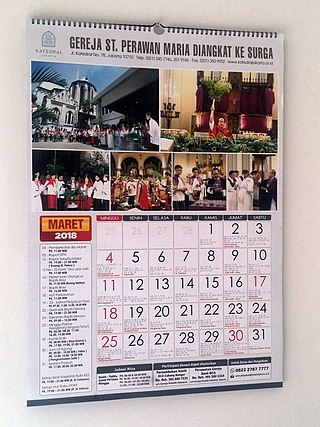
A calendar is a system of organizing days. This is done by giving names to periods of time, typically days, weeks, months and years. A date is the designation of a single and specific day within such a system. A calendar is also a physical record of such a system. A calendar can also mean a list of planned events, such as a court calendar, or a partly or fully chronological list of documents, such as a calendar of wills.

The traditional Chinese calendar, dating back to the Han dynasty, is a lunisolar calendar that blends solar, lunar, and other cycles for social and agricultural purposes. While modern China primarily uses the Gregorian calendar for official purposes, the traditional calendar remains culturally significant. It determines the timing of Chinese New Year with traditions like the twelve animals of the Chinese Zodiac still widely observed.

The Hebrew calendar, also called the Jewish calendar, is a lunisolar calendar used today for Jewish religious observance and as an official calendar of Israel. It determines the dates of Jewish holidays and other rituals, such as yahrzeits and the schedule of public Torah readings. In Israel, it is used for religious purposes, provides a time frame for agriculture, and is an official calendar for civil holidays alongside the Gregorian calendar.

The Hijri calendar, or Arabic calendar, also known in English as the Muslim calendar and Islamic calendar, is a lunar calendar consisting of 12 lunar months in a year of 354 or 355 days. It is used to determine the proper days of Islamic holidays and rituals, such as the annual fasting and the annual season for the great pilgrimage. In almost all countries where the predominant religion is Islam, the civil calendar is the Gregorian calendar, with Syriac month-names used in the Levant and Mesopotamia, but the religious calendar is the Hijri one.

ISO 8601 is an international standard covering the worldwide exchange and communication of date and time-related data. It is maintained by the International Organization for Standardization (ISO) and was first published in 1988, with updates in 1991, 2000, 2004, and 2019, and an amendment in 2022. The standard provides a well-defined, unambiguous method of representing calendar dates and times in worldwide communications, especially to avoid misinterpreting numeric dates and times when such data is transferred between countries with different conventions for writing numeric dates and times.
The Julian calendar is a solar calendar of 365 days in every year with an additional leap day every fourth year. The Julian calendar is still used as a religious calendar in parts of the Eastern Orthodox Church and in parts of Oriental Orthodoxy as well as by the Amazigh people.
A leap year is a calendar year that contains an additional day compared to a common year. The 366th day is added to keep the calendar year synchronised with the astronomical year or seasonal year. Since astronomical events and seasons do not repeat in a whole number of days, calendars having a constant number of days each year will unavoidably drift over time with respect to the event that the year is supposed to track, such as seasons. By inserting ("intercalating") an additional day—a leap day—or month—a leap month—into some years, the drift between a civilization's dating system and the physical properties of the Solar System can be corrected.

A lunar calendar is a calendar based on the monthly cycles of the Moon's phases, in contrast to solar calendars, whose annual cycles are based on the solar year. The most widely observed purely lunar calendar is the Islamic calendar. A purely lunar calendar is distinguished from a lunisolar calendar, whose lunar months are brought into alignment with the solar year through some process of intercalation – such as by insertion of a leap month. The details of when months begin vary from calendar to calendar, with some using new, full, or crescent moons and others employing detailed calculations.
A month is a unit of time, used with calendars, that is approximately as long as a natural phase cycle of the Moon; the words month and Moon are cognates. The traditional concept of months arose with the cycle of Moon phases; such lunar months ("lunations") are synodic months and last approximately 29.53 days, making for roughly 12.37 such months in one Earth year. From excavated tally sticks, researchers have deduced that people counted days in relation to the Moon's phases as early as the Paleolithic age. Synodic months, based on the Moon's orbital period with respect to the Earth–Sun line, are still the basis of many calendars today and are used to divide the year.

The New Year is the time or day at which a new calendar year begins and the calendar's year count increments by one. Many cultures celebrate the event in some manner. In the Gregorian calendar, the most widely used calendar system today, New Year occurs on January 1. This was also the first day of the year in the original Julian calendar and the Roman calendar.

The year is a unit of time based on the roughly 365¼ days taken by the Earth to revolve around the Sun. The contemporary calendar year, based on the Gregorian solar calendar, approximates this cycle.

In the Gregorian calendar, New Year's Day is the first day of the calendar year, 1 January. Most solar calendars, such as the Gregorian and Julian calendars, begin the year regularly at or near the northern winter solstice. In contrast, cultures and religions that observe a lunisolar or lunar calendar celebrate their Lunar New Year at varying points relative to the solar year.

The calendar of saints is the traditional Christian method of organizing a liturgical year by associating each day with one or more saints and referring to the day as the feast day or feast of said saint. The word "feast" in this context does not mean "a large meal, typically a celebratory one", but instead "an annual religious celebration, a day dedicated to a particular saint".
The Hindu calendar, also called Panchanga, is one of various lunisolar calendars that are traditionally used in the Indian subcontinent and Southeast Asia, with further regional variations for social and Hindu religious purposes. They adopt a similar underlying concept for timekeeping based on sidereal year for solar cycle and adjustment of lunar cycles in every three years, but differ in their relative emphasis to moon cycle or the sun cycle and the names of months and when they consider the New Year to start. Of the various regional calendars, the most studied and known Hindu calendars are the Shalivahana Shaka found in the Deccan region of Southern India and the Vikram Samvat (Bikrami) found in Nepal and the North and Central regions of India – both of which emphasize the lunar cycle. Their new year starts in spring. In regions such as Tamil Nadu and Kerala, the solar cycle is emphasized and this is called the Tamil calendar and Malayalam calendar and these have origins in the second half of the 1st millennium CE. A Hindu calendar is sometimes referred to as Panchangam (पञ्चाङ्गम्), which is also known as Panjika in Eastern India.

Lunar New Year is the beginning of a new year based on lunar calendars or, informally but more widely, lunisolar calendars. Lunar calendars follow the lunar phase while lunisolar calendars follow both the lunar phase and the time of the solar year. The event is celebrated by numerous cultures in various ways at diverse dates.

Old Style (O.S.) and New Style (N.S.) indicate dating systems before and after a calendar change, respectively. Usually, they refer to the change from the Julian calendar to the Gregorian calendar as enacted in various European countries between 1582 and 1923.

The Indian national calendar, also called the Shaka calendar or Śaka calendar, is a solar calendar that is used alongside the Gregorian calendar by The Gazette of India, in news broadcasts by All India Radio, and in calendars and official communications issued by the Government of India. It was adopted in 1957 following the recommendation of the Calendar Reform Committee.
A fiscal year is used in government accounting, which varies between countries, and for budget purposes. It is also used for financial reporting by businesses and other organizations. Laws in many jurisdictions require company financial reports to be prepared and published on an annual basis but generally with the reporting period not aligning with the calendar year. Taxation laws generally require accounting records to be maintained and taxes calculated on an annual basis, which usually corresponds to the fiscal year used for government purposes. The calculation of tax on an annual basis is especially relevant for direct taxes, such as income tax. Many annual government fees—such as council tax and license fees— are also levied on a fiscal year basis, but others are charged on an anniversary basis.
The Gregorian calendar is the calendar used in most parts of the world. It went into effect in October 1582 following the papal bull Inter gravissimas issued by Pope Gregory XIII, which introduced it as a modification of, and replacement for, the Julian calendar. The principal change was to space leap years differently so as to make the average calendar year 365.2425 days long, more closely approximating the 365.2422-day "tropical" or "solar" year that is determined by the Earth's revolution around the Sun.

The Bengali Calendar, is a solar calendar used in the Bengal region of the South Asia. A revised version of the calendar is the national and official calendar in Bangladesh and an earlier version of the calendar is followed in the Indian states of West Bengal, Tripura and Assam. Unlike the traditional Indian Hindu calendar which starts with the month of Choitro, the Bengali calendar starts with Boishakh because of the reforms made during the reign of the Mughal Emperor Akbar in Mughal Bengal. The first day of the Bengali year is known as Pohela Boishakh which is a public holiday in Bangladesh.